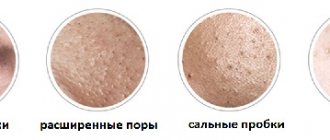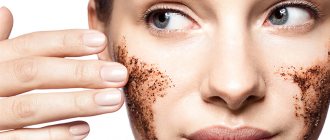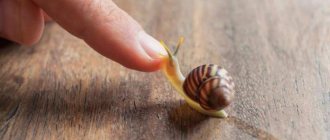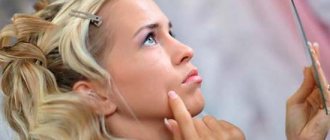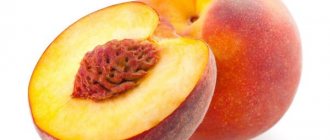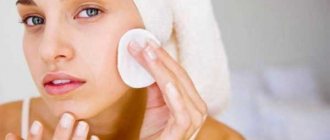Why do pimples and blackheads appear?
Masks will help reduce the number of rashes or completely rid you of them for some time. But a complete cure for the problem will only come from getting rid of the cause of acne. It may lie in the following factors:
- abuse of fatty foods;
- improper facial hygiene or its complete absence;
- hormonal imbalances;
- disruption of the digestive system;
- problems with the reproductive system;
- allergic reaction to decorative or caring cosmetics;
- reaction to the use of some medications (most often contraceptives).
Only an examination by a doctor will help you find out the cause of acne and forgotten pores. You should start with a dermatologist; if necessary, he will refer you to the right specialist.
Homemade masks for oily skin
To choose the right product for oily skin type, it is necessary to eliminate problems that contribute to increased secretion of the sebaceous glands. Most importantly, it is necessary to exclude common factors - poor nutrition and inadequate care. If we talk about external care, then first of all it is necessary to remove oily shine, narrow pores and relieve inflammation.
Homemade masks for oily skin
The most popular components in masks for problematic, oily-prone skin are distinguished by the presence of skin-drying ingredients:
- yeast;
- sour berries and fruits;
- clay;
- cereals;
- dairy products;
- egg white.
One of the unique products for oily skin is a steaming mask:
- oatmeal (about 1 spoon);
- 1/2 spoon of soda;
- some milk.
Oatmeal nourishes, moisturizes and cleanses the skin
Mix cereal and soda, add warm milk, dilute the mixture to a soft consistency. Massage the problem areas with the resulting mass and do not rinse for 15-20 minutes. This remedy is especially effective for enlarged pores, acne, pimples and inflammation.
Clay and mud masks are the best helpers for caring for oily skin.
To prepare a clay mask you will need:
- 2 tablespoons of clay in powder form (you can take white or blue clay separately or mix them in equal proportions);
- some water;
- a few drops of hydrogen peroxide;
- a few drops of tea tree oil.
Clay mixtures have an excellent drying effect.
Mix all ingredients until creamy. Apply to your face and let the mixture soak in for about 30 minutes. Rinse your face.
A mud mask will soothe and saturate oily skin with beneficial microelements. The mud of the Dead Sea or the mud of Lake Tambukan have proven themselves to be excellent. Thanks to the unique natural properties of these products, acne quickly dries out and inflammation is eliminated. A mud mask can be made not only in the salon, but also at home. To do this, just buy the required powder at the pharmacy and dilute it in water. Before using the mud, you need to prepare your face - clean it with a scrub and steam it over a herbal bath. The mud product should be kept on the face for no longer than 20-30 minutes and rinsed with warm water. Before using the mud mask, you need to treat a small area to test the sensitivity of the skin.
For oily skin covered with acne, a yeast mask is perfect:
- ½ pack of fresh yeast;
- boiled water.
Mix a piece of yeast with water until it becomes pasty. The resulting mixture should not spread or be too thick. Apply the mask to your face and leave to absorb for about 20 minutes. Remove the dried yeast piece by piece, then rinse with water. It is useful to make this mixture once every 3-4 days until the pimples disappear.
Homemade masks for dry skin
Masks for problematic facial skin with constant dryness and flaking should contain moisturizing or nourishing ingredients from the list:
- oil (any cosmetic or olive);
- high fat dairy products;
- juices of vegetables and non-acidic fruits, purees from them;
- egg yolk.
A mask based on apple and milk will perfectly moisturize dry skin:
- one small apple;
- a glass of milk.
Green apple with milk - ideal mask ingredients for dry skin
Peel, cut, boil the apple in milk, mash with a spoon until pureed, let cool to a comfortable temperature, apply the mixture to your face, hold for about 30 minutes. For dryness and peeling, you can also use fresh grated apples. In this case, you can soften the sour apple juice with a spoon of sour cream. In addition to the moisturizing effect, apple-based masks perfectly tone the skin and remove signs of fatigue.
Clay is a great way to care for problem skin prone to dryness and irritation. For example, a cleansing mask made from red or black clay is ideal for increased sensitivity and flaking. You just need to buy powdered clay of the desired color at the pharmacy and dilute it in water until it becomes pasty. You can keep this product for 20-30 minutes. Rinse your face with water and enjoy the result.
During the cool season, dry and sensitive skin lacks nutrition and vitamins. In this case, a nourishing vitamin mask for problem skin with persimmon would be an excellent solution:
- 1 spoon of persimmon pulp;
- 1 spoon of butter;
- 1 yolk;
- ½ spoon of honey.
Persimmon nourishes and saturates the skin with vitamins
Mix all ingredients until smooth, apply the resulting mixture to your face, do not rinse for 15-20 minutes. Persimmon has good protective properties, which is especially important in unfavorable conditions outside the window.
Homemade masks for mixed skin types
We also recommend reading: Face mask with cucumber
Combination skin is especially capricious, so choosing a mask to effectively care for it is not so easy.
A nourishing mask for combination skin is easily prepared from berries and cottage cheese:
- several strawberries or raspberries;
- 1 spoon of cottage cheese.
Mash the berries with a spoon and mix with cottage cheese until pureed. Apply the mixture to your face, except for the lips and eyes, and do not rinse for 15-20 minutes. Thanks to berry juice, the face will be nourished with vitamins and get rid of oily shine, and cottage cheese will perfectly moisturize dry areas.
A moisturizing mixture based on apple and honey tones and restores the protective functions of combination skin:
- 1 apple;
- 1 spoon of honey;
- 1 spoon of oatmeal.
Finely grate the apple, mix with floured oatmeal and honey. Apple saturates the face with vitamins, flour dries out oily areas, and honey tones and gives a healthy appearance.
To give combination skin firmness and elasticity, you can use a soothing herbal mask:
- 1 spoon of sage,
- 1 spoon of mint;
- 1 spoon of rose hips;
- half a lemon.
Herbal masks will relieve common skin problems and saturate it with vitamins
Mix the herbs, add hot water, leave in a water bath for 30-40 minutes, cool, mix with the juice of half a lemon. Do not strain the mixture. Apply the product to the face through gauze. The herbal mask is very effective for various skin problems; it helps not only cleanse, but also refresh and soothe the face.
Effective homemade masks
Cleansing masks will not cure hormonal problems or improve metabolism. But they will provide wonderful support for the skin. It will be expressed in:
- nutrition with necessary elements;
- drying out pimples;
- relieving inflammation;
- pulling out impurities from pores;
- regulation of the sebaceous glands;
- narrowing pores.
By making such masks at home, you pamper your skin, help it renew itself and cleanse deeper. Regular use will help improve the overall condition of the skin, and not just solve the problem of rashes.
Gelatin film masks
Film masks pull out impurities and blackheads from pores. At home they are made using gelatin. Classic recipe:
- Dissolve a pack of gelatin in 100 ml of milk.
- Heat the mixture (you can either in the microwave or in a water bath).
- Apply to the skin, avoiding the hairline and eyebrow area, wait until completely dry, leave for 30 minutes.
- Remove like a film, in small pieces.
Black film mask:
- Crush the activated carbon tablet to powder, mix with a teaspoon of gelatin.
- Dilute in water, heat.
- Apply the mixture to your face and wait until it dries.
- Do not keep it for longer than 30 minutes.
- Remove by pulling the edge of the mask.
Film mask with soda:
- Dissolve a pack of gelatin in a nourishing face cream, just take one tablespoon.
- After thickening, add 1 teaspoon of baking soda.
- Heat the whole mass.
- Apply to the face, hold until it hardens (and 10-15 minutes after), remove like a film.
Honey based masks
Mask with honey and aspirin for healing:
- Dissolve 2 aspirin tablets in water until they form a paste (crush them first).
- Mix with a spoon of fresh natural honey.
- Apply to skin for 20 minutes, rinse.
Composition with lemon and egg for blackheads:
- Beat 2 eggs until stiff foam.
- Pour in a tablespoon of liquid natural honey, add a few drops of lemon juice.
- Apply for 30 minutes.
Scrub masks with oatmeal
With nourishing coconut oil:
- Melt a tablespoon of coconut oil, add 2 tablespoons of aloe juice and a couple of drops of lemon juice.
- Add abrasive ingredients - a little sea salt and a tablespoon of crushed flakes.
- Apply onto the skin using massage movements and leave on for 20 minutes.
For sensitive skin:
- Brew green tea, pour 2 tablespoons into a separate container.
- Add a pinch of cinnamon and chopped oat flakes.
- Wait for the flakes to swell.
- Leave the composition on the skin for 20 minutes before washing off.
Honey-oatmeal scrub mask:
- Melt 2 tablespoons of honey, add 1 tablespoon of crushed flakes.
- Apply to the skin using massage movements.
- Then leave for 15 minutes.
Cosmetic clay masks
With chloramphenicol, whitening:
- Grind 2 tablets into powder.
- Add 2 tablespoons of white clay and talc.
- Mix thoroughly and dilute with hydrogen peroxide, a 3% solution.
- Keep on skin for no longer than 15 minutes.
Face mask with cosmetic clay
With vegetable juice:
- Mix blue clay to obtain a thick paste with cucumber and lemon juices (an equal mixture).
- Spread the mixture on your face.
- Leave for 15-20 minutes before rinsing with warm water.
With sea buckthorn oil for antibacterial effect:
- Mix 2 tablespoons of black clay with the same amount of aloe extract.
- Add a teaspoon of sea buckthorn oil.
- Apply for 20 minutes.
With bodyaga:
- Dilute the bodyaga with water to a paste.
- Add cosmetic clay.
- Keep for 20 minutes, then wash.
Egg masks
Composition of yolk and aloe:
- Grind the aloe leaf, mix with egg yolk and a teaspoon of kefir.
- Place a thick layer on your face.
- Keep for 15 minutes, rinse thoroughly with warm water.
Drying protein mask:
- Separate the chicken protein from the yolk.
- Beat until foamy.
- Apply a layer on face until dry.
- Once dry, apply another layer and repeat until the beaten egg whites are gone.
- Leave for 10 minutes, rinse thoroughly.
Whitening and drying mask:
- Pour a teaspoon of fresh lemon juice (squeeze about a third of the lemon) into the beaten egg white.
- Distribute the mixture over the face.
- Wait until it dries completely, then apply another layer, then another.
- After applying the last layer, wait 10 minutes and rinse.
Vegetable masks
Turnips and carrots to relieve inflammation:
- Boil turnips and carrots, 1 piece each.
- Mash the vegetables until puree, mix, put on your face.
- Leave on for 20 minutes before washing.
Cucumber mask:
- Mix 1/4 teaspoon of baking soda with grated cucumber.
- Apply the mixture to the skin.
- Keep for 15 minutes, rinse with cool water.
TOP 5 best homemade acne masks
The best homemade face masks for acne are made from a variety of ingredients that have anti-inflammatory properties. We bring to your attention a rating of the most effective recipes, according to which you can easily and quickly prepare very effective remedies.
- Black mask
A homemade black face mask for acne can be prepared from three main ingredients: activated carbon, black clay and medicinal mud. Along with rashes, it perfectly solves the problem of blackheads. Dilute 30 grams of pharmaceutical mud powder with a small amount of filtered warm water to obtain a creamy mass. Duration of action - according to the instructions (from 15 to 40 minutes).
- Soda
Quite aggressive, a soda for acne for the face is used for very oily and contaminated skin. If your skin is sensitive and thin, it is better not to use this recipe. Mix 30 grams of brewer's yeast with 10 grams of baking soda. Dilute with a small amount of filtered warm water to a creamy consistency. Action time: 10-15 minutes.
- From laundry soap
Another effective, but no less aggressive remedy is an acne mask made from laundry soap , which is also recommended only for oily, problem skin and is contraindicated for dry and sensitive skin. Soak a small piece of laundry soap in warm water and beat until a thick foam forms. Mix 3 teaspoons of this foam with a pinch of baking soda. Apply directly to pimples for half an hour.
- From tar soap
An effective anti-acne mask made from tar soap . Grate a small piece of it, add warm water, beat until foam forms. Apply it directly to problem areas of the face. Rinse off after 5-7 minutes. If used correctly, within a couple of minutes the skin will begin to burn, a feeling of tightness and discomfort will appear - this is a normal reaction that must be endured.
- From henna
made from henna (colorless), which is known for its anti-inflammatory properties, can achieve excellent results Dilute 15 grams of henna powder with warm, strongly brewed green tea to form a thick paste. Add 10 ml calendula oil.
Judging by the reviews, these homemade acne mask recipes effectively cope with any rash, including acne. Products made from cosmetic clay also have an anti-inflammatory effect.
Be careful. Anti-acne masks made from tar and laundry soap are, of course, good, but they require maximum control: they are contraindicated for the care of sensitive, dry, thin and couperose skin.
Other recipes
Massage lines for applying the mask composition
Peeling mask with tea tree oil:
- Beat the egg, add a few drops of tea tree oil, and half a spoon of sugar.
- Stir until smooth.
- Keep on the skin for 20 minutes, be sure to apply with massage movements along the massage lines.
Soda drying mask:
- Make a soap solution, mix it in equal quantities with soda.
- Apply to clean skin that is not damaged by open wounds, scratches or fresh inflammation.
- After 15 minutes, rinse off.
Soothing herbal decoction mask:
- Prepare gauze with slits or take a store-bought template for homemade masks.
- Brew chamomile infusion, make an infusion of calendula.
- Mix the infusions, moisten the mask blank in the resulting liquid, and cover your face with it.
- Lie down with this compress for 30 minutes, then wash.
Paraffin mask:
- Heat cosmetic paraffin for depilation to a comfortable temperature.
- Apply to the entire face or only to problem areas, apply tracing paper on top.
- Wait until the paraffin hardens completely.
- Remove it from your face along with the tracing paper, wash your face and don’t forget to apply a thin layer of nourishing cream.
To tighten pores:
- Mix a third of a glass of oat flour (you can simply grind the oats yourself in a coffee grinder) with a small amount of fresh honey.
- Add 2 tablespoons of apple cider vinegar.
- Apply to skin and leave for 10-15 minutes depending on how sensitive your skin is.
Acne masks from pharmaceutical drugs
- From activated carbon
A classic anti-acne mask made from black activated carbon first of all cleanses the skin of harmful substances that cause breakouts on the skin. Crush 2-3 tablets, mix with any liquid: in the fight against acne, it is better to use aloe juice or a decoction (infusion) of calendula, string, or chamomile. The resulting black paste is applied to the face pointwise for 10-15 minutes.
- Aspirin
Treatment mask with Aspirin for the face against acne - antibacterial action. Dilute 2 crushed tablets with milk or chamomile decoction to the desired consistency. Action time: no more than 5-7 minutes. Do it no more often than every other day.
- From Polysorb
A cleansing, anti-toxic mask made from Polysorb against acne for the face will make your skin radiant and clean in 2 months of continuous treatment. Mix 30 grams of crushed Polysorb capsules with 10 grams of granulated sugar and 10 grams of onion puree. Action time: 10 minutes.
- With badyaga
Homemade acne masks with badyaga attract instant action. Dilute the pharmaceutical seaweed powder with 2% boric acid to a creamy consistency.
- With hydrogen peroxide
A homemade mask with hydrogen peroxide for acne will draw out all the rot from under the skin, which provokes the formation of rashes on the skin. Dilute 15 grams of black clay powder with filtered warm water until a thick paste forms. Add 4 drops of hydrogen peroxide and 10 ml of cosmetic macadamia oil.
- With mumiyo
with mumiyo for acne can be a good helper Pour 2 crushed mummy tablets with 20 ml of warm plantain decoction. Add 10 ml of calendula oil and 5 ml of strongly brewed green tea.
- Alginate
A good alternative to Badyaga is an alginate acne mask - also made from algae. Dilute 30 grams of blue clay powder with warm water until the desired consistency is obtained. Add 15 ml of liquid honey and 10 grams of powdered alginate. Knead thoroughly. Action time: 10-15 minutes.
- With vitamin E
To treat problem skin, make acne masks with vitamin E , which promotes rapid regeneration of damaged tissue. Dilute 15 grams of red clay powder with warm green tea to form a thick mass. Add an ampoule of tocopherol and 2 drops of anise essential oil.
- With Levomycetin
An antibacterial acne mask with Levomycetin is good, but it often causes a skin rash as a side effect. So be careful with this antibiotic. Mix 1 crushed tablet of Levomycetin and Aspirin. Dilute them with calendula tincture to make a paste. Action time: 10 minutes.
- With Enterosgel
A cleansing acne mask with Enterosgel is an analogue of the same product with activated carbon, since this drug is also designed to remove toxins and harmful substances from the body. Buy a paste with this name and apply a thick layer to your face for 20 minutes.
- Zinc
To dry out rashes on your face, a zinc acne mask handy. Mix 15 grams of zinc paste (or ointment) with raw egg yolk, 10 ml of liquid honey and 20 grams of low-fat cottage cheese.
- Dimexide
A liquid mask with Dimexide for acne is more like a tonic. Dissolve 10 ml of dimexide in 20 ml of calendula decoction. Add 3 drops of tea tree ether. Apply to problem areas daily for 10 days.
- With Vishnevsky ointment
If you can tolerate odors well, make masks from Vishnevsky ointment for acne. To prepare it, you need to take a fabric base with slits for the eyes and nose, thoroughly soak it in a medicinal product and apply it to your face for... 2.5 hours. The effect is amazing!
- With Analgin and Streptocide
Another antibacterial mask for acne - with Analgin and Streptocide . Crush 1 tablet of Analgin and Streptocide. Dilute with chamomile decoction until a paste forms.
- With boric acid
with boric acid have excellent anti-inflammatory properties (to prepare them, it is better to take a 2% pharmaceutical preparation). Mix 15 grams of oatmeal with a pinch of baking soda, add 5 ml of boric acid, dilute to the desired consistency with low-fat kefir.
- From Paracetamol
An unexpected acne mask made from Paracetamol has gained inexplicable popularity recently. Mix 1 crushed tablet of Aspirin and Paracetamol. Dilute with calendula tincture to a mushy state. Apply spotwise for 15 minutes.
- Ichthyol
A homemade ichthyol mask for acne is used when ulcers form, as it perfectly pulls out all this rot from under the skin. Ichthyolka can not even be mixed with anything. Just apply it directly to the pimples for a couple of hours and wash off with clean water.
- With propolis
An anti-acne mask with propolis , a bee product that has excellent anti-inflammatory properties, has healing properties. Pour 20 grams of black clay with 40 ml of chamomile decoction. Add 5 ml of alcohol solution of propolis and 10 ml of lemon juice. Keep on face for 15 minutes.
- With Trichopolum
Thanks to its wide spectrum of action, a mask with Trichopolum (the main active ingredient is metronidazole) for acne is collecting a huge number of positive reviews. Crush 4 tablets of Levomycetin and Trichopolum. Fill a bottle (50 ml) with salicylic alcohol. Shake well. Apply directly to inflamed areas of the face for 15-20 minutes.
- Glycerin
with glycerin for acne at home Mix 5 ml of warm glycerin with 20 ml of chamomile decoction. Pour 10 grams of badyagi powder into this mixture.
- With vitamin A
If you regularly make acne masks with vitamin A , then there will be no trace left of them. Mix 10 grams of baby cream with 1 ampoule of retinol acetate. Keep on face for 10 minutes.
- With Amoxicillin
An antibacterial mask with Amoxicillin for acne will work if you do it every other day for 2 weeks. Mix 2 crushed tablets with aloe juice and apply to spots for 10 minutes.
- With Nise
Another unexpected mask for acne is with the Nise tablet , the recipe for which is increasingly found in reviews on the Internet. It is unlikely to get rid of this problem, but it will slightly relieve inflammation and also eliminate discomfort and pain when opening ulcers, since the main effect of this drug is to eliminate pain. Crush 2 Nise tablets, mix with baby cream in equal proportions, dilute with sea buckthorn oil to the desired consistency.
Keep in mind. When using acne face masks, remember that none of them will save you from this natural disaster until you get rid of the root cause of the breakouts.
Rules for using masks
Homemade masks against acne and blackheads will be effective only if you strictly adhere to the recipes and rules for their use. Here are the most common ones:
- You can use any masks only when there are no wounds, injuries or serious inflammations on your face.
- Regular use of masks at home is the key to success. 1-2 times a week is enough.
- For deeper penetration of mask components into the skin, it is recommended to steam.
- You can also apply the compositions after you have left the steam room in the bathhouse, the effectiveness will increase.
- Masks must be washed off. Even after removing the film mask, you need to wash yourself thoroughly.
- Don't forget to apply a nourishing cream with moisturizing ingredients after the procedure.
Knowing how to make an effective cleansing mask at home can help you consistently give your skin the care it deserves. Without spending large sums on cosmetics with a similar effect. But complete relief from acne is only possible if the cause of its appearance is eliminated.
Ready-made masks for problem skin
Cettua mask is the ideal solution for problem skin
Masks for problem skin can be purchased ready-made at the pharmacy or prepared at home yourself. Of the ready-made masks, it is worth especially noting the Cettua company’s product with tea tree oil, which is in particular demand, and the Bark mask.
Cettua is suitable for problematic skin suffering from various types of rashes. Thanks to tea tree oil, which has proven itself to be an excellent antibacterial agent, Cettua not only quickly relieves inflammation and removes pimples, but also prevents new ones from appearing. Massaging problem areas, gently apply the mask to a cleansed face and hold for 20-30 minutes. There is no need to wash it off. The result is noticeable immediately after use - pores become smaller, the complexion becomes more even, and the skin becomes smoother.
A mask with fruit acids Bark quickly tidies up problematic skin prone to inflammation, acne and pimples. In addition, it perfectly improves elasticity, evens out complexion, and prevents premature aging. Citric and lactic acid in the composition cleanse and tone the skin. Thanks to grape seed oil, fine wrinkles are removed and the face acquires a healthy complexion. To achieve the desired effect, it is recommended to use the product no more than 2 times a week in courses of 15 procedures. Apply the product in a thin layer to a prepared and cleansed face, hold for no more than 8 minutes and rinse with warm water.
However, finished products are not suitable for everyone, since intolerance to any component may occur at any time. Therefore, the best way to take care of your appearance is to individually select ingredients that are available to everyone at home. Here are some accessible recipes for masks for the care of dry, oily and combination skin, which can be prepared at home from available products.
Cora brand product will fight back acne and inflammation
What components fight problem skin?
Women with problem skin often suffer from rashes, oily shine, and redness. Enlarged pores spoil the relief of the epidermis and are constantly clogged with dirt, dust, and cosmetics. To get rid of acne and pimples, you need to regularly make masks, cleanse at home or in a beauty salon.
Homemade face masks that save you from acne and blackheads should contain the following products:
- cucumber – eliminates minor acne, moisturizes the face;
- carrots – reduces enlarged pores, evens out the relief;
- kiwi – refreshes, kills pathogenic bacteria, nourishes the epidermis with microelements;
- clay (blue, black, white) – cleanses blackheads, regulates sebum production, heals inflammatory elements;
- fresh yeast – nourishes the skin with vitamins and microelements;
- oatmeal – removes oily shine, cleanses pores, saturates with vitamin B, dries;
- chicken egg white – absorbs oily sheen;
- honey – reduces the size of pustules, eliminates redness;
- baking soda - kills bacteria that cause acne.
Also for cleaning pores, home recipes contain activated carbon, aspirin, tar soap, and henna. You can reduce inflammation with seaweed, avocado oil, aloe juice, and ginger. To improve the condition of the dermis, it is recommended to use olive oil. Calendula tincture also effectively fights acne.
Recommendations from cosmetologists
To eliminate skin problems, it is necessary to systematically care for it. Experts recommend choosing the right skincare and decorative cosmetics and regularly visiting the salon for professional cleaning. It is better to purchase face masks against acne at a pharmacy or make your own.
At home, adhere to the following rules:
- Adjust your diet. Most often, skin problems arise due to excessive consumption of fast carbohydrates, fatty, smoked, fried foods, and alcohol. If you suffer from constipation, be sure to take a therapeutic course of taking lactobacilli, pre and probiotics.
- Do not crush pimples or blackheads. Even if you disinfect your hands and the inflamed area, there is a risk of infection and damage to the integument. There are spots on the face that do not go away for a long time. Scars and scars can be reduced only with the help of a laser.
- To cleanse your face, use steam baths and soft scrubs. Once a week, steam your skin over a herbal decoction of chamomile, calendula, St. John's wort, and thyme.
- Do not use powder or foundation with a thick texture that clogs pores. During an exacerbation of acne, you should not cover them up. This makeup emphasizes acne even more. In rare cases, you can get rid of redness using a corrector or concealer.
To make your skin clearer, drink enough water (at least 1.5 liters) and get enough sleep. Do not touch your face or apply cosmetics with dirty hands, especially if you have open wounds. Makeup brushes should be treated with an antiseptic and washed in soapy water every week.
